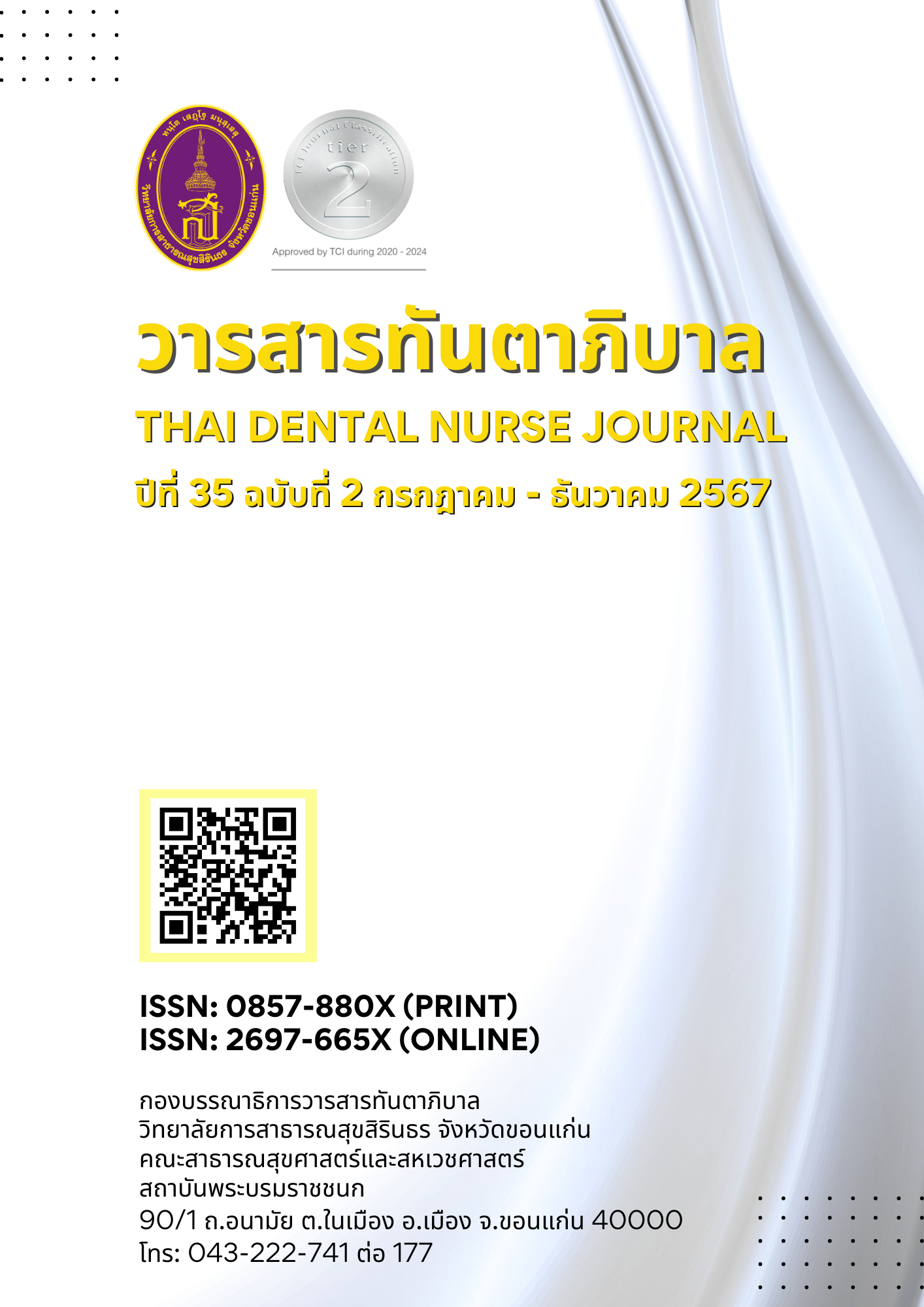Factors Related to Dry Teeth-Brushing Technique Behavior among Senior High School Students in Secondary Schools, Roi Et Province
Keywords:
Teeth-brushing behavior, Dry teeth-brushing technique, High school studentAbstract
This research was a cross-sectional descriptive study that aimed to investigate factors related to dry teeth-brushing behavior among senior high school students in a secondary school located in Roi Et province. The sample consisted of 218 students who were recruited using stratified and cluster random sampling. Data were collected using a questionnaire with a value of reliability 0.703. Data were analyzed using descriptive statistics, chi-square test and Fisher’s exact test.
The study showed that the majority of students had a mean age of 16.3 years (S.D. = 0.9) and most were female (60.1%). Most were in the 4th year of secondary schools (45.4%). The combined monthly income of their parents was predominantly 19,575.1 baht, accounting for 17.0% of the sample. A significant proportion of students (71.1%) had oral health problems, and 69.3% visited a dental professional more than once a year. The majority of students practiced dry brushing (64.7%). There was a statistically significant relationship between students' dry brushing behavior and their grade level and frequency of dental visits (p-value = 0.042 and 0.004, respectively).
Based on the results, a significant correlation exists between visits to dental personnel and dry teeth-brushing behavior. Therefore, dental professionals should provide ongoing dental health education to the public, with a particular focus on dry teeth-brushing.
References
โรงพยาบาลเปาโลโชคชัย 4. “โรคฟันผุในเด็ก” ปัญหาเล็ก ๆ ที่อาจกลายเป็นเรื่องใหญ่ [อินเทอร์เน็ต]. 2561 [เข้าถึงเมื่อ 1 กรกฎาคม 2566]. เข้าถึงได้จาก: https://www.paolohospital.com/th-TH/chokchai4/Clinic/Details/%E0%B8%81%E0%B8%B8%E0%B8%A1%E0%B8%B2%E0%B8%A3%E0%B9%80%E0%B8%A7%E0%B8%8A
สำนักทันตสาธารณสุข กรมอนามัย. รายงานผลการสำรวจสภาวะสุขภาพแห่งชาติ ครั้งที่ 8 ประเทศไทย พ.ศ. 2560. พิมพ์ครั้งที่ 1. กรุงเทพฯ: สามเจริญพาณิชย์ (กรุงเทพ) จำกัด; 2561.
ฝ่ายทันตกรรม โรงพยาบาลพนมไพร. รายงานผลการสำรวจสภาวะทันตสุขภาพตามกลุ่มวัยอำเภอพนมไพร จังหวัดร้อยเอ็ด. ร้อยเอ็ด: โรงพยาบาลพนมไพร; 2564.
จิติมา เอื้อรัตนวงศ์, ดลหทัย สิทธิพงษ์พร. การศึกษาระดับความรู้เกี่ยวกับการแปรงฟันแห้ง และปัจจัยที่มีผลต่อความเข้าใจวิธีการแปรงแห้งของผู้รับบริการทางทันตกรรมในโรงพยาบาล วชิรพยาบาล. วชิรเวชสารและวารสารเวชศาสตร์เขตเมือง. 2565; 66(5): 311-20.
พรศรี ปฏิมานุเกษม, ทัชชา ทรรปณ์จินดา, ธนพล รี้พลมหา. ปริมาณฟลูออไรด์ในน้ำลายหลังการแปรงฟัน โดยบ้วน และไม่บ้วนปาก. วิทยาสารทันตสาธารณสุข. 2555; 17(2): 109-16.
Sjögren K, Birkhed D. Effect of various post-brushing activities on salivary fluoride concentration after toothbrushing with a sodium fluoride dentifrice. Caries Res. 1994; 28(2): 127-31.
สุดาดวง กฤษฎาพงษ์. แปรงแห้ง. วารสารวิชาการสาธารณสุข. 2560; 26 ฉบับเพิ่มเติม 2: 348-59.
Machiulskiene V, Richards A, Nyvad B, Baelum V. Prospective study of the effect of post-brushing rinsing behaviour on dental caries. Caries Res. 2002; 36(5): 301-7.
บุหงา ชัยสุวรรณ, พรพรรณ ประจักษ์เนตร. พฤติกรรมการใช้สื่อใหม่ของวัยรุ่นอายุระหว่าง 10-19 ปี. วารสารการสื่อสารและการจัดการ. 2558; 1(1): 31-57.
Porter CM. Revisiting Precede–Proceed: A leading model for ecological and ethical health promotion. Health Education Journal. 2016; 75(6): 753-64.
ศุภกร ศิริบุรี, พันพัสส์ ปาระมี. การพัฒนารูปแบบการฝึกแปรงฟันในเด็กที่มีความบกพร่องทางการมองเห็น โรงเรียนการศึกษคนตาบอดแม่สาย อำเภอแม่สาย จังหวัดเชียงราย. เชียงรายเวชสาร. 2561; 10(1): 103-11.
อรุณ จิรวัฒน์กุล. สถิติทางวิทยาศาสตร์สุขภาพเพื่อการวิจัย. กรุงเทพฯ: วิทยพัฒน์; 2553.
Likert R. New Patterns of Management. McGraw-Hill; 1961.
Best JW. Research in education. 4th ed. New Jersey: Prentice-Hall; 1981.
บุญชัช เมฆแก้ว. การพัฒนาชุดช่วยวิเคราะห์ข้อมูลแบบเรียลไทม์หาค่าความเชื่อมั่นแบบทดสอบ (KR-20). รายงานวิจัยเพื่อพัฒนาการเรียนการสอน. พังงา: วิทยาลัยชุมชนพังงา สถาบันวิทยาลัยชุมชน; 2563.
วรเมธ สุขพาสันติ, มานพ คณะโต. การแปรงฟันหลังอาหารกลางวันที่โรงเรียนของเด็กนักเรียนประถมศึกษาตอนปลาย ในจังหวัดหนองบัวลําภู. วารสารการพัฒนาสุขภาพชุมชน มหาวิทยาลัยขอนแก่น. 2559; 4(1): 113-26.
เบญญาภา ผิวนวล, ขวัญวิภา เวทการ, ปริญญา จิตอร่าม, ธนกฤต ธนวงศ์โภคิน. ปัจจัยที่มีความสัมพันธ์กับพฤติกรรมการแปรงฟันในช่วงพักกลางวันที่โรงเรียนของนักเรียน ชั้นประถมศึกษาปีที่ 6 โรงเรียนอนุบาลสุพรรณบุรี. วารสารทันตาภิบาล. 2562; 30(1): 15-28.
ศิริพร คุยเพียภูมิ. ปัจจัยที่มีความสัมพันธ์กับพฤติกรรมส่งเสริมสุขภาพช่องปากของนักเรียนมัธยมศึกษา โรงเรียนนครวิทยาคม ตำบลสันมะเค็ด อำเภอพาน จังหวัดเชียงราย [วิทยานิพนธ์ปริญญาสาธารณสุขศาสตรมหาบัณฑิต]. พะเยา: มหาวิทยาลัยพะเยา; 2555.
วรเมธ สุขพาสันติ, มานพ คณะโต, พูนรัตน์ ลียติกุล. ปัจจัยที่มีความสัมพันธ์กับการแปรงฟันหลังอาหารกลางวันที่ โรงเรียนของเด็กนักเรียนประถมศึกษาตอนปลายในจังหวัดหนองบัวลำภู. ศรีนครินทร์เวชสาร. 2559: 31(2): 169-77.
วรรธนะ พิธพรชัยกุล, เสมอจิต พิธพรชัยกุล, ทรงชัย ฐิตโสมกุล, อังคณา เธียรมนตรี, นุชนรี อัครชนียากร, นงนุช อาคาสุวรรณ และคณะ. กิจกรรมการแปรงฟันและปัจจัยที่เกี่ยวข้อง ในโรงเรียนประถมศึกษาจังหวัดสงขลา ประเทศไทย. วิทยาสารทันตแพทยศาสตร์. 2552; 59(3): 190-99.
Downloads
Published
Issue
Section
License
Copyright (c) 2024 Thai Dental Nurse Journal

This work is licensed under a Creative Commons Attribution-NonCommercial-NoDerivatives 4.0 International License.
บทความที่ได้รับการตีพิมพ์ถือเป็นลิขสิทธิ์ของวารสารทันตาภิบาล




